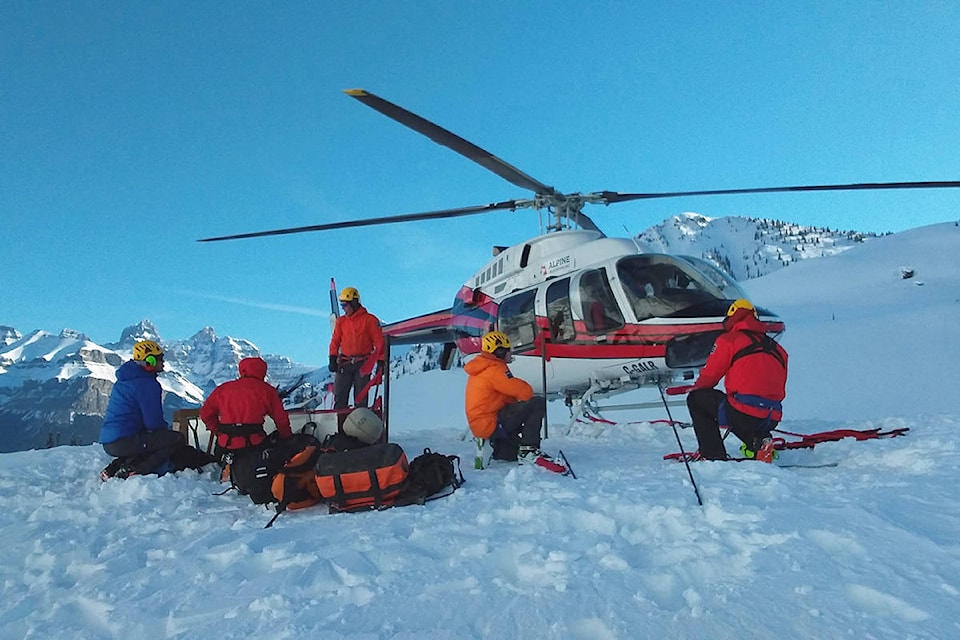Outdoor experts are hoping that an avalanche that killed three world-class climbers last spring will lead to improved safety in the sport.
American Jess Roskelley and Austrians David Lama and Hansjorg Auer disappeared in April as they tried to descend Howse Peak in the Rocky Mountains. Rescuers have said the search was challenging because the three weren’t wearing avalanche beacons.
The avalanche, which made international news, turned a spotlight on climbers and why many don’t carry safety gear.
Grant Statham, a mountain risk specialist for Parks Canada, said climbers want to be light, but anyone who’s in avalanche terrain should have a beacon, a probe and a shovel.
“You sometimes hear climbers say, ‘There’s no point in me wearing this equipment because, if I get hit by an avalanche, I’ll be killed,’ which in some cases is true,” he said in an interview.
“Except that there is a point in wearing the equipment because somebody is going to have to come in there and find you.”
READ MORE: Bodies of 3 mountain climbers recovered after Banff avalanche
Parks Canada has been working for years to improve safety for ice climbers with information bulletins and early-season avalanche warnings, he said.
A study in the Canadian Medical Association Journal in 2009 found that 58 per cent of climbers were asphyxiated and 42 per cent died from trauma in a 21-year period.
“You are buried and you can’t breathe, (but) there’s always a chance that you can dig people out in certain situations,” Statham said.
He and colleague Stephen Holeczi wrote a paper in 2016 looking at the death of a climber earlier that year at Polar Circus, a 700-metre climb on a frozen waterfall. They found that 15 rescuers spent nearly 80 hours doing avalanche control, searching and digging to find the man.
“If a person was wearing a transceiver and we had to dig them out, we could do it in 14 hours,” he said. “If they had both been wearing transceivers, his partner could have dug him out and left him on the surface.”
Statham said the man’s body was found — 200 metres below the surface — using a faint signal from a Recco strip, a type of rescue technology on his head lamp.
After the Howse Peak avalanche, rescuers threw transceivers out of a helicopter to mark the spot before bad weather came in and caused more snowslides.
“The pilot actually held the hover, while we stayed clipped to a line and searched,” he recalled. “It was pretty edgy in there doing that work.”
The three men were finally found by a search dog.
Statham said family and friends of anyone caught in an avalanche always want the body back.
“You cannot underestimate how important it is,” he said during a panel at the Banff Mountain Film Festival in November. “Wearing that equipment — it’s bigger than you.”
Will Gadd, an ice climber and paraglider based in Canmore, Alta., also appeared on the panel. He said he’s lost friends in the mountains, including some who weren’t found for years.
“They were gone … and it would have been nice to say goodbye to them.”
Paragliders have come to wear personal locator beacons, he said.
“If you show up … and you don’t have a (GPS tracking device), you are an idiot,” he said. “Why can’t we solve it in climbing?”
Gadd said it’s unacceptable some of his friends couldn’t be found and others on the rescue team had to put themselves in danger to locate them.
“We need to solve this,” said Gadd, who noted he’s trying to get gear manufacturers to add Recco strips to harnesses and other climbing equipment.
Parks Canada officials said they would like to see some changes after the headline-grabbing deaths last spring.
“The literature calls these focusing events,” said Statham. “All of a sudden a big thing happens and people change.”
There were policy changes for backcountry skiing, he said, after seven students from a private school near Calgary were killed in 2003 on an outdoor education trip in Rogers Pass, B.C.
Changes also took place in snowmobiling in 2010 when two people were killed and 31 others were injured after an avalanche swept through a crowd watching an event near Revelstoke, B.C.
“I would like to think that the Howse Peak incident, sad as it was …is an opportunity for us to make some change,” Statham said.
Colette Derworiz, The Canadian Press
Like us on Facebook and follow us on Twitter.
